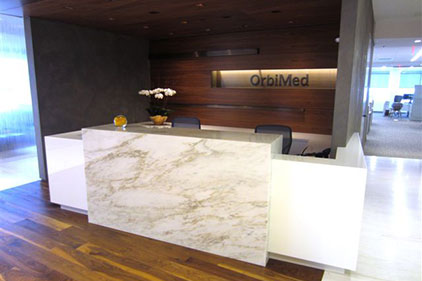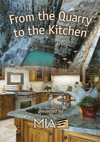
|
| A visit to a recently renovated office of an investment firm, located in a Lexington Avenue skyscraper in Manhattan, revealed a reception desk made out of Danby marble and Glassos®. |
My first stop was to the recently renovated office of an investment firm, located in a Lexington Avenue skyscraper and boasting a large wall of glass windows that offered sprawling views of Manhattan. A co-worker and I met with a fabricator from New Jersey who had furnished the reception desk out of Danby marble and Glassos® -- a crystal white material made of pure white crystallized glass and described as the "closest substitute for Thassos White marble." He explained that the pure white material, which was used to form both corners of the elaborate desk, was the ideal complement to the slab of Danby marble that forms the face of the desk because it didn't compete with it.
I took a few things away from our meeting with the fabricator. I'd say the underlying theme was to "think outside the box." Especially in these tough economic times, it is important for companies to diversify and find new ways to attract customers. In the case of this fabricator, he worked with a manufacturer to produce Glassos and have it receive a registered trademark. The material has become a huge success for the company, and has helped to increase business.
The fabricator also mentioned how he has become the guy that people turn to when they have been told by others that it can't be done. He explained how it challenges him and pushes him to find a solution. With that said, good craftsmanship is also tremendously important. In the case of the reception desk, the mitered corners were completed on the jobsite to ensure that everything was accurate and didn't get damaged in transit.
My second stop of the day was to the office of an architect that I have known for several years now. We first met on a trip to Cevisama in Valencia, Spain, which was sponsored by Tile of Spain. We have kept in touch over the years, and I have written about several of his project in both Contemporary Stone & Tile Design and its sister publication, TILE Magazine. This actually was the reason for my visit, as he had just completed several new projects that I wanted to learn more about.
During our conversation, I started thinking about the fact that I am talking with an architect who has designed high-profile hospitality projects both here in the U.S. and abroad. One of the projects we discussed was a new Italian restaurant at the Mohegan Sun casino in Connecticut. When I have conversations such as this one, I realize that when visiting these projects as a patron, I look at things differently than the regular customer. Rather than just enjoying the food, I take interest in the architecture and the stone and products used in the design. I understand all that went into making the restaurant or hotel what it has become.
Another thing that struck me in our conversation was how my architect friend discussed the fact that budget doesn't necessarily have to dictate the design. He likes the challenge of developing a compelling design even when funds are tight. It just takes a little more thought. He mentioned how he recently helped out a friend's son who owns a restaurant in New Jersey. He created a chandelier out of lights that were being sold for $7.99 at Ikea. After seeing the picture, I would have never have guessed if he hadn't told me.
My New York City outing yesterday only reiterated to me that the small things are important. Attention to detail and considering all the options when obstacles might present themselves is important to achieving a successful outcome -- whether it is a design, or stone or tile installation.










